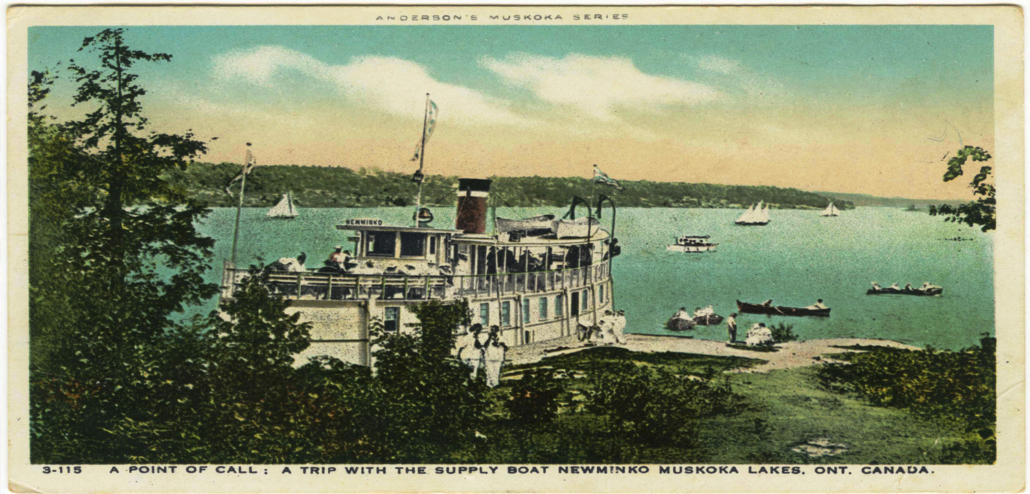
William Alfred Anderson was born at Skipton in Yorkshire, England December 21st, 1880. When he was a young man he went to sea, and travelled a good part of the world ending up in Cape Town, South Africa during the Boer War. He and a friend decided to join a light horse cavalry unit in Port Elizabeth some distance up the east coast. However, by the time they arrived the war was over!
After returning to England he took up photography and in 1907 he and his brother Harry decided to immigrate to Canada with the intention of going to British Columbia. However, during the voyage he met a man who persuaded him to break his journey long enough to visit the Muskoka district of Ontario which he claimed had a great natural beauty and being a photographer he was persuaded. This man was a friend of Edward Prouse, who pioneered, along with his brother-in-law John Willmott, the region of Lake Muskoka and particularly the area known as Tondern Island. Tondern Island became known as Beaumaris. William was to spend the rest of his life there.
By the time William arrived in Canada, Edward Prouse had established a large summer hotel in Beaumaris as Lake Muskoka had become a tourist destination. William was most impressed with Muskoka’s natural beauty. He set up his business in space Mr. Prouse rented to him in the hotel.
The Muskoka region was fast becoming a favourite summer paradise for well-to-do Americans who came by train to Gravenhurst and then by steamboat to the various resorts on the lakes. Both Mr. Prouse and Mr. Willmott sold real estate, on the island and the main land, to summer visitors who wanted their own summer homes.
Both the Prouse family and the Willmott family were large with nine children each. They were the only year-round families in Beaumaris.
In 1909 William married one of the Willmott daughters, Frances. They built a house in Beaumaris as well as a photographic studio. During the first few years of their marriage William and Frances went to Florida during the winter where William established a photographic studio at Daytona Beach.
William then went to work as a staff photographer for the Toronto Telegram. However, he did not stay long at this as his heart was in Muskoka. Over the years he began accumulating a number of very good views around the lakes and before the First World War he began a series of picture postcards in “sepia”. His views covered many hotels, lodges and beauty spots all over the three Muskoka Lakes. After the First World War he was able to locate a German publisher who could reproduce his card series in colour. He published the “Anderson Muskoka Lakes Series” and the “Anderson Lake of Bays Series”. Over the years he took and had produced as many as two hundred and fifty different views and each year he would import these picture postcards in the hundreds of thousands from Germany. They sold over the counter for two or five cents and people could not get enough of them.
He would take a view, send it to Toronto where a copper engraving would be made and then it was mounted on a hard wood block. This block was sent to the publishers in Germany who would produce thousands of copies from the one engraving. The engravings were expensive items. Each spring as the cards arrived from Germany he would go up the lakes in his boat taking orders from all the hotels, lodges, towns, villages etc. Then he would cover the Lake of Bays district in his car doing the same thing. When he returned home he would make up the orders with the assistance of his children and their cousins who all loved to help. The packages would be shipped by steamboat all over the lakes.
He was constantly on call to photograph people’s boats, summer homes, yacht club functions. In one instance a man approached him to take some aerial views of his property on one of the lakes. This was just after the First World War and the man had a hydro plane on floats which he flew privately. William took him up on it although flying was not the safest thing in those days. However, the man turned out to be Billy Bishop, V.C. who was the great flying ace of the First World War.
He took many pictures of a variety of things over the years and enjoyed a good business in postcards until 1936. In 1936 when he tried to place his order with his German publishers he could not get any response by cable or letter. It turned out that the German publishers were Jewish and Hitler had put them out of business. William lost all his copper engravings which were the key to publication. He carried on for a while with a Canadian producer who used a gelatin process instead of a copper engraving. The gelatin process only stood up for one publication and had to be melted down. It was a poor reproduction with bad colour and cost twice as much. As a result he abandoned it and went for black and white glossy cards. These were expensive to produce and he had to sell them for ten cents each. With the onset of World War II William decided to retire from the postcard business. However, he continued his other photographic work.
During their 1939 royal visit to Canada, King George and Queen Elizabeth were to visit the Muskoka Lakes. Unfortunately their itinerary was changed due to the pending war and the Muskoka Lake visit was cancelled. Monck Township then commissioned William to produce an album of 20 views of the area. The album was entitled “A Photographic Glimpse of the Famous Muskoka Lakes, The Highlands of Ontario”. It was presented to the King and Queen by the Lieutenant Governor at Queen’s Park in Toronto. The album is part of the Royal Photographic collection at Windsor Castle.
William never lost his love of the lakes and lived in Beaumaris until he died in 1962 at age 82.
By his son William Everritt Willmott Anderson
Editor’s Notes: Thanks to Susan Anderson for supplying this information
Muskoka Boat and Heritage Centre has several of Mr. Anderson’s post cards





